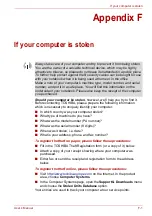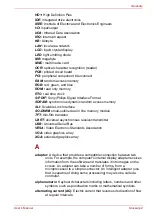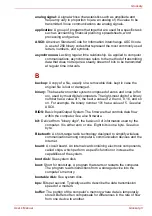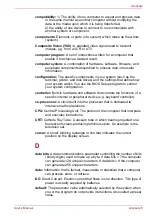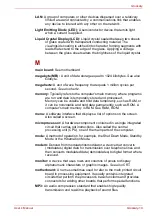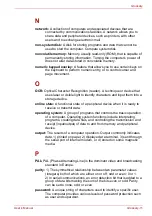
User’s Manual
Glossary-13
Glossary
resolution:
A measure of the sharpness of the images that can be
produced by a printer or displayed on a screen. For a printer,
resolution is expressed in dots per inch (dpi). For a screen, it is
expressed as the number of pixels available horizontally and
vertically
restart:
Resetting a computer without turning it off (also called "warm
boot", "soft reset" or "reboot"). See also boot.
RGB:
Red, green and blue. A device that uses three input signals, each
activating an electron gun for a primary additive color (red, green
and blue) or port for using such a device.
See also
CRT.
RJ11:
A modular telephone jack.
RJ45:
A modular LAN jack.
S
S/P DIF:
A standard of digital interface for audio.
SCSI:
Small Computer System Interface is an industry standard interface
for connection of a variety of peripheral devices.
SD/SDHC memory card:
Secure Digital cards are flash memory widely
used in a variety of digital devices such as digital cameras and
Personal Digital Assistants.
SECAM L:
SECAM (Sequential Color Memory) is a broadcasting standard
used in France.
SIO:
Serial Input/Output. The electronic methodology used in serial data
transmission.
soft key:
Key combinations that emulate keys on the IBM keyboard,
change some configuration options, stop program execution, and
access the numeric keypad overlay.
software:
The set of programs, procedures and related documentation
associated with a computer system. Specifically refers to computer
programs that direct and control the computer system activities.
See also
hardware.
stop bit:
One or more bits of a byte that follow the transmitted character or
group codes in asynchronous serial communications.
synchronous:
Having a constant time interval between successive bits,
characters or events.
system disk:
A diskette that contains the operating system files needed to
start the computer. Any diskette can be formatted as a system disk.
A system disk is also called a "bootable disk", "boot disk" or a
"startup disk." Compare non-system disk.

